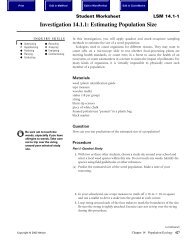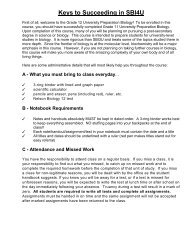Chapter 4.pdf
Chapter 4.pdf
Chapter 4.pdf
You also want an ePaper? Increase the reach of your titles
YUMPU automatically turns print PDFs into web optimized ePapers that Google loves.
4.2<br />
Physical and Chemical Properties<br />
Here is a summary of what you<br />
will learn in this section:<br />
• Physical properties describe<br />
the characteristics of a<br />
substance that can be<br />
observed or measured.<br />
• Chemical properties describe<br />
the reactivity of a substance<br />
and ways in which it forms new<br />
substances.<br />
• Physical properties include<br />
hardness, conductivity, colour,<br />
density, melting point,<br />
solubility, and viscosity.<br />
• Chemical properties include<br />
combustibility and reaction<br />
with water or acid.<br />
Figure 4.17 A fire produces many changes in matter.<br />
The Chemistry of a Campfire<br />
A fire can be fascinating to watch (Figure 4.17). Although all the<br />
flames look similar, each particular spark and flicker is unique —<br />
never to be repeated in exactly the same way. With investigation,<br />
however, some patterns become clear. Chemistry reveals that all<br />
forms of burning are variations on a theme. Every fire needs the<br />
same three components: fuel, oxygen gas, and heat.<br />
In a campfire, the fuel is wood, a complex natural material<br />
that is rich in carbon. Carbon reacts with oxygen in the air but<br />
only if the air can reach the carbon in the wood. This is why the<br />
first step in building a campfire is usually to split a log into tiny<br />
splinters, called kindling. By chopping a thick log into kindling,<br />
much more carbon in the wood is exposed to the air. Oxygen gas<br />
has easy access to the carbon at the surface of the wood and so<br />
can react with it.<br />
The components of a fire must be in just the right balance.<br />
When lighting a fire, extra oxygen is sometimes needed. This is<br />
why gentle blowing on the first embers of the fire can help. There<br />
is enough oxygen in the breath to provide the extra boost. It is<br />
important not to blow the heat of the first sparks away from the<br />
fuel, however, as this will blow out the fire. Because combustion<br />
releases heat, there is no need to keep relighting the flame.<br />
148 UNIT B Atoms, Elements, and Compounds
















